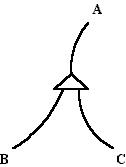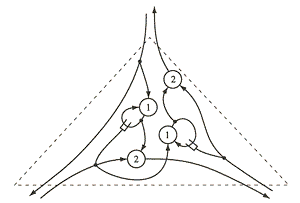Difference between revisions of "AND node"
(New page.) |
m (made correction(s) to citation format) |
||
| (7 intermediate revisions by 2 users not shown) | |||
| Line 1: | Line 1: | ||
| − | An '''AND node''' is a [[node (in neurocognitive linguistics)|node]] in [[compact relational network notation | + | An '''AND node''' is a [[node (in neurocognitive linguistics)|node]] in relational network notation. The AND node takes two forms, both of which are defined in this article: |
| + | |||
| + | * The ''AND node'' of [[compact relational network notation]]. | ||
| + | * The ''AND node'' of [[narrow relational network notation]]. | ||
| + | |||
| + | === In Compact Notation === | ||
| + | |||
| + | An AND is represented by an isosceles triangle about half as tall as it is wide, with [[line|lines]] connecting to other nodes. The node can be oriented with the apex at top ("downward AND") or bottom ("upward AND"). One line connects to the apex and two or more lines to the opposite (long) side; those two or more lines represent a conjunctive relationship. The AND node shows combinations as opposed to alternations, which are shown by the [[OR node]]. The ''downward AND'' accounts for composite [[realization]]--situations in which a function or meaning is represented by multiple units of expression occurring together, e.g., "news-paper". An ''upward AND'' represents portmanteau realization, the situation in which an item of expression represents a combination of higher-level units, as "went" realizes "go" and "PAST". | ||
| + | |||
AND nodes have two principal types: | AND nodes have two principal types: | ||
==== Ordered AND ==== | ==== Ordered AND ==== | ||
| − | The lines on the plural side | + | The lines on the plural side operate in sequence, left to right. This type of AND shows the relationship of concatenation. |
| + | [[Image:Orderand.jpg]] | ||
In this example, downward activation from A goes to B ''and later'' to C. Upward activation from B ''and later'' from C goes to A. | In this example, downward activation from A goes to B ''and later'' to C. Upward activation from B ''and later'' from C goes to A. | ||
| Line 13: | Line 22: | ||
In this example, downward activation travels through the line on the singular side, through the node, then down both lines on the plural side simultaneously. Upward activation travels up both plural-side lines simultaneously, then through the node and up the singular-side line. | In this example, downward activation travels through the line on the singular side, through the node, then down both lines on the plural side simultaneously. Upward activation travels up both plural-side lines simultaneously, then through the node and up the singular-side line. | ||
| − | === | + | === In Narrow Notation === |
| − | + | Here is an ordered AND in narrow notation: | |
| + | |||
| + | [[Image:OrderedAnd.gif]] | ||
=== Sources === | === Sources === | ||
| − | * [http://www.ruf.rice.edu/~lngbrain LangBrain] | + | *[http://www.ruf.rice.edu/~lngbrain LangBrain] |
| − | * Lamb, Sydney M. | + | *[[Sydney M. Lamb|Lamb, Sydney M.]] 1999. Pathways of the Brain: The Neurocognitive Basis of Language. Amsterdam: John Benjamins. |
{{dc}} | {{dc}} | ||
| + | [[Category:En]] | ||
[[Category:DICT]] | [[Category:DICT]] | ||
| − | |||
[[Category:Grammar]] | [[Category:Grammar]] | ||
| − | [[Category: | + | [[Category:Stratificational_Grammar]] |
Latest revision as of 02:05, 15 October 2017
An AND node is a node in relational network notation. The AND node takes two forms, both of which are defined in this article:
- The AND node of compact relational network notation.
- The AND node of narrow relational network notation.
In Compact Notation
An AND is represented by an isosceles triangle about half as tall as it is wide, with lines connecting to other nodes. The node can be oriented with the apex at top ("downward AND") or bottom ("upward AND"). One line connects to the apex and two or more lines to the opposite (long) side; those two or more lines represent a conjunctive relationship. The AND node shows combinations as opposed to alternations, which are shown by the OR node. The downward AND accounts for composite realization--situations in which a function or meaning is represented by multiple units of expression occurring together, e.g., "news-paper". An upward AND represents portmanteau realization, the situation in which an item of expression represents a combination of higher-level units, as "went" realizes "go" and "PAST".
AND nodes have two principal types:
Ordered AND
The lines on the plural side operate in sequence, left to right. This type of AND shows the relationship of concatenation.
 In this example, downward activation from A goes to B and later to C. Upward activation from B and later from C goes to A.
In this example, downward activation from A goes to B and later to C. Upward activation from B and later from C goes to A.
Unordered AND
A different type of combination in which the components are simultaneous. The multiple lines connect to the same point on the plural side of the triangle.
 In this example, downward activation travels through the line on the singular side, through the node, then down both lines on the plural side simultaneously. Upward activation travels up both plural-side lines simultaneously, then through the node and up the singular-side line.
In this example, downward activation travels through the line on the singular side, through the node, then down both lines on the plural side simultaneously. Upward activation travels up both plural-side lines simultaneously, then through the node and up the singular-side line.
In Narrow Notation
Here is an ordered AND in narrow notation:
Sources
- LangBrain
- Lamb, Sydney M. 1999. Pathways of the Brain: The Neurocognitive Basis of Language. Amsterdam: John Benjamins.
